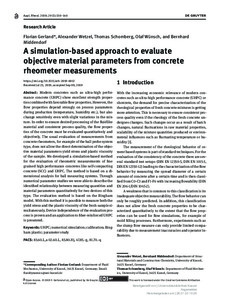Aufsatz

A simulation-based approach to evaluate objective material parameters from concrete rheometer measurements
Zusammenfassung
Modern concretes such as ultra-high performance concrete (UHPC) show excellent strength properties combined with favorable flow properties. However, the flow properties depend strongly on process parameters during production (temperature, humidity etc.), but also change sensitively even with slight variations in the mixture. In order to ensure desired processing of the fluidlike material and consistent process quality, the flow properties of the concrete must be evaluated quantitatively and objectively. The usual evaluation of measurements from concrete rheometers, for example of the ball probe system type, does not allow the direct determination of the objective material parameters yield stress and plastic viscosity of the sample. We developed a simulation-based method for the evaluation of rheometric measurements of fine grained high performance concretes like self-compacting concrete (SCC) and UHPC. The method is based on a dimensional analysis for ball measuring systems. Through numerical parameter studies we were able to describe the identified relationship between measuring quantities and material parameters quantitatively for two devices of this type. The evaluation method is based on the Bingham model. With this method it is possible to measure both the yield stress and the plastic viscosity of the fresh sample simultaneously. Device independence of the evaluation process is proven and an application to fiber-reinforced UHPC is presented.
Zitierform
In: Applied Rheology Band 29 / Heft 1 (2019-12-31) , S. 130-140 ; ISSN 1617-8106Förderhinweis
Gefördert durch den Publikationsfonds der Universität KasselZitieren
@article{doi:10.17170/kobra-20200128962,
author={Gerland, Florian and Wetzel, Alexander and Schomberg, Thomas and Wünsch, Olaf and Middendorf, Bernhard},
title={A simulation-based approach to evaluate objective material parameters from concrete rheometer measurements},
journal={Applied Rheology},
year={2019}
}
0500 Oax 0501 Text $btxt$2rdacontent 0502 Computermedien $bc$2rdacarrier 1100 2019$n2019 1500 1/eng 2050 ##0##http://hdl.handle.net/123456789/11440 3000 Gerland, Florian 3010 Wetzel, Alexander 3010 Schomberg, Thomas 3010 Wünsch, Olaf 3010 Middendorf, Bernhard 4000 A simulation-based approach to evaluate objective material parameters from concrete rheometer measurements / Gerland, Florian 4030 4060 Online-Ressource 4085 ##0##=u http://nbn-resolving.de/http://hdl.handle.net/123456789/11440=x R 4204 \$dAufsatz 4170 7136 ##0##http://hdl.handle.net/123456789/11440
<resource xsi:schemaLocation="http://datacite.org/schema/kernel-2.2 http://schema.datacite.org/meta/kernel-2.2/metadata.xsd"> 2020-01-28T10:17:10Z 2020-01-28T10:17:10Z 2019-12-31 doi:10.17170/kobra-20200128962 http://hdl.handle.net/123456789/11440 Gefördert durch den Publikationsfonds der Universität Kassel eng Urheberrechtlich geschützt https://rightsstatements.org/page/InC/1.0/ UHPC numerical simulation calibration Bingham plastic parameter study 530 540 A simulation-based approach to evaluate objective material parameters from concrete rheometer measurements Aufsatz Modern concretes such as ultra-high performance concrete (UHPC) show excellent strength properties combined with favorable flow properties. However, the flow properties depend strongly on process parameters during production (temperature, humidity etc.), but also change sensitively even with slight variations in the mixture. In order to ensure desired processing of the fluidlike material and consistent process quality, the flow properties of the concrete must be evaluated quantitatively and objectively. The usual evaluation of measurements from concrete rheometers, for example of the ball probe system type, does not allow the direct determination of the objective material parameters yield stress and plastic viscosity of the sample. We developed a simulation-based method for the evaluation of rheometric measurements of fine grained high performance concretes like self-compacting concrete (SCC) and UHPC. The method is based on a dimensional analysis for ball measuring systems. Through numerical parameter studies we were able to describe the identified relationship between measuring quantities and material parameters quantitatively for two devices of this type. The evaluation method is based on the Bingham model. With this method it is possible to measure both the yield stress and the plastic viscosity of the fresh sample simultaneously. Device independence of the evaluation process is proven and an application to fiber-reinforced UHPC is presented. open access Gerland, Florian Wetzel, Alexander Schomberg, Thomas Wünsch, Olaf Middendorf, Bernhard doi:10.1515/arh-2019-0012 publishedVersion ISSN 1617-8106 Heft 1 Applied Rheology 130-140 Band 29 </resource>
Die folgenden Lizenzbestimmungen sind mit dieser Ressource verbunden:
Urheberrechtlich geschützt

